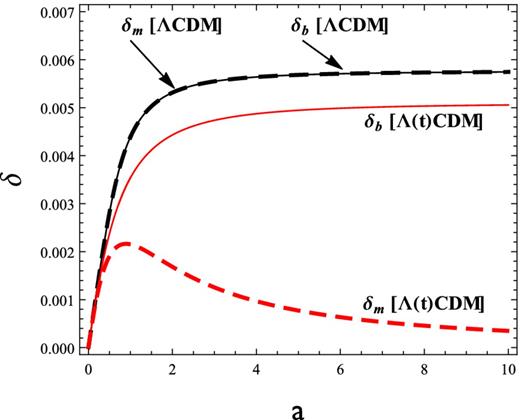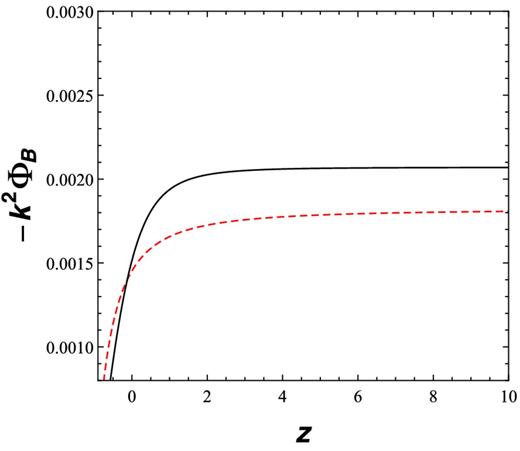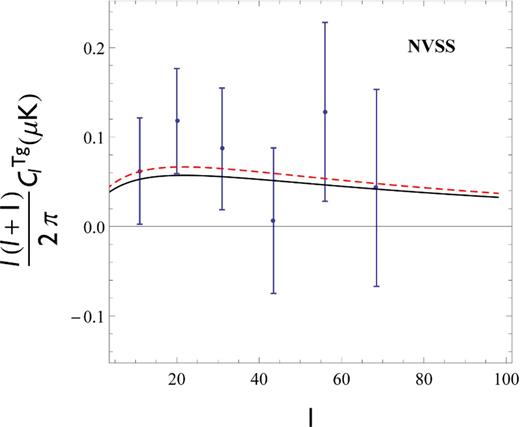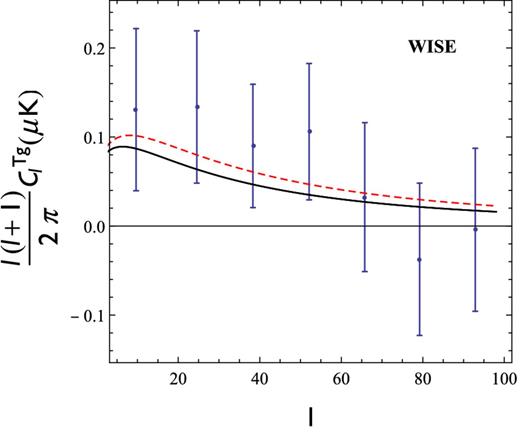-
PDF
- Split View
-
Views
-
Cite
Cite
H. Velten, H. A. Borges, S. Carneiro, R. Fazolo, S. Gomes, Large-scale structure and integrated Sachs–Wolfe effect in decaying vacuum cosmology, Monthly Notices of the Royal Astronomical Society, Volume 452, Issue 2, 11 September 2015, Pages 2220–2224, https://doi.org/10.1093/mnras/stv1443
Close - Share Icon Share
Abstract
The concordance particle creation model – a class of Λ(t) Cold Dark Matter (CDM) cosmologies – is studied using large-scale structure (LSS) formation, with particular attention to the integrated Sachs–Wolfe effect. The evolution of the gravitational potential and the amplitude of the cross-correlation of the cosmic microwave background (CMB) signal with LSS surveys are calculated in detail. We properly include in our analysis the peculiarities involving the baryonic dynamics of the Λ(t)CDM model which were not included in previous works. Although both the Λ(t)CDM and the standard cosmology are in agreement with available data for the CMB–LSS correlation, the former presents a slightly higher signal which can be identified with future data.
INTRODUCTION
Although the great success of the standard ΛCDM cosmological model in describing most observations, we are still distant from the full understanding of the cosmic dynamics. Apart from the so-called small-scale problems in the dark matter sector, there is also a huge discussion about dark energy properties. At the same time, the efficient approach given by a cosmological constant Λ still seems to face some challenges, mainly from the theoretical point of view.
Among the viable alternatives, it has been argued that a model with the mechanism of dark matter particle production at a constant rate Γ (implying in a dynamical vacuum term Λ(t)) is also capable to produce a concordance model (Alcaniz et al. 2012), although with a larger current matter fraction Ωm0 ≈ 0.45.1
Concerning structure formation, the full cosmic microwave background (CMB) spectrum has not yet been obtained for this model, but CMB physics can also be accessed via integrated Sachs–Wolfe (ISW) studies, i.e. how time-varying gravitational potential wells change the temperature of the CMB photons as they cross structures (Sachs et al. 1967). The expansion of an Einstein–de Sitter universe compensates the clustering of structures, producing no ISW effect, i.e. in a matter dominated universe there is no ‘late time’ ISW effect.3 Dark energy modifies the background expansion and leads to a net contribution to (ΔT/T)ISW. Then, it is expected that the modified background and perturbative expansion of the Λ(t)CDM model leaves a distinct imprint on the ISW signal.
Since the ISW is a secondary CMB temperature effect its detection occurs only via the cross-correlation with other large-scale probes like galaxies and quasars surveys (Crittenden et al. 2005). Wang et al. (2010) used the cross-correlation technique to probe the Λ(t)CDM model, finding an increase of the ISW-galaxy spectrum (|$C^{Tg}_l$|) in comparison to the ΛCDM model. Our aim in this paper is to perform this analysis taking care with some peculiarities of the model. In particular, it is important to differentiate the evolution of the baryonic and dark matter components. At the background level, baryons are included in the conserved part of equation (3). Concerning perturbations, the observed matter power spectrum P(k) = |δ(k)|2 is a measurement of the baryonic clustering, which is sourced by the gravitational potential. In the ΛCDM model there is almost no difference between the evolution on large scales of such components. The same does not happen in the Λ(t)CDM model, where one observes a late-time suppression in the dark matter and total matter contrasts owing to dark matter production, a suppression not observed in the baryonic contrast.
Our interest is also justified by a possible tension between the theoretical ΛCDM predictions and the observed ISW signal. Some analysis have reported a cross-correlation signal 1σ–2σ above that expected in the standard cosmology (Giannantonio et al. 2008; Goto, Szapudi & Granett 2012, see Giannantonio et al. 2012 for a critical review on this issue). Recent studies claim a better statistical concordance though the observed signal is still higher than the theoretical one (Kovács et al. 2013; Ferraro, Sherwin & Spergel 2015). Also, the inferred stacking of CMB data on the position of superstructures is about five times larger than the ΛCDM prediction (Granett, Neyrinck & Szapudi 2008; Nadathur, Hotchkiss & Sarkar 2012; Flender, Hotchkiss & Nadathur 2013; Hernández-Monteagudoet & Smith 2013). This result has recently been confirmed by the 2015 release of the Planck CMB data (Planck Collaboration 2015).
In the next section we develop the background expansion which will be used in this paper. In Section 3 we explore the scalar perturbations of the model. The connection with the ISW effect is made via a direct calculation of the evolution of the gravitational potential (Section 3.2) and the ISW–LSS cross-correlation (Section 3.3). We conclude in the final section.
Λ(t) BACKGROUND DYNAMICS
PERTURBATIVE DYNAMICS
Growth functions
In Fig. 1 we plot the evolution of the density contrasts as calculated in equations (11) and (12). For the ΛCDM model (black curves) we set Ωm0 = 0.23, the best fit of LSS observations (Cole et al. 2005; Percival et al. 2007).5 We show the Λ(t)CDM evolutions for δb and δm in the solid red and dashed red curves, respectively. We have used initial conditions δb(a = 0.001) = δm(a = 0.001) = 10−5 and |$\delta ^{\prime }_{{\rm b}}(a=0.001)=\delta ^{\prime }_{{\rm m}}(a=0.001)=0$|. As expected, δb and δm have the same evolution in the standard case. On the other hand, the plot shows a late-time growth suppression of δm in the Λ(t)CDM model, a consequence of dark matter creation. The same suppression is not observed in the baryonic contrast, though its amplitude achieves a plateau on late times which is slightly below the standard scenario.

Evolution of the linear density contrasts. The black curves correspond to the baryonic (solid black curve) growth and total matter (dashed black curve) growth for the ΛCDM model with Ωm0 = 0.23. Related plots for the Λ(t)CDM with Ωm0 = 0.45 are in solid red (baryons) and dashed red (total matter), respectively.
Evolution of the gravitational potential
The baryonic and total matter density contrasts can be directly calculated from the solution of equations (11) and (12). Using equation (14), we compare in Fig. 2 the predictions for the ΛCDM and Λ(t)CDM gravitational potentials as functions of the redshift z. We access the observational predictions for the ISW effect via the cross-correlation of CMB maps and LSS surveys, to be done in next section.

Evolution of the gravitational potential for the ΛCDM model with Ωm0 = 0.23 (black) and for the Λ(t)CDM with Ωm0 = 0.45 (red dashed).
Correlating CMB maps and galaxy surveys
The redshift distribution of the observed galaxy sample is a model-independent quantity. Each survey has its own dN/dz histogram function. We use in this work data from the NRAO VLA Sky Survey (NVSS)7 and the Wide-field Infrared Survey Explorer (WISE)8 catalogues. Both surveys are widely used for cross-correlation studies. The NVSS covers the entire north sky of −40 deg declination in one band. The produced catalogue of discrete sources contains more than one million objects. Full details appear in Condon et al. (1998). WISE has an entire sky scanning strategy in four frequency bands. It has an average redshift 0.3, but reaching up to z ∼ 1, collecting about 500 million sources which are in general not restricted to point-like objects such as stars and unresolved galaxies. The data used in this work are taken from the analysis recently performed in Ferraro et al. (2015) which uses a larger sample by applying less-conservative cuts to the data set in comparison to previous works (Goto et al. 2012; Kovács et al. 2013).
The resulting cross-correlation spectrum is show in Figs 3 and 4. For the NVSS data (Fig. 3) we follow the presentation of data used in Wang et al. (2010), where the original data points of Ho et al. (2008) located at l < 10 and l > 70 have been removed due to their high dispersion. The WISE data presented in Fig. 4 are taken from Ferraro et al. (2015). In both cases, the |$C^{Tg}_l$| spectrum for the Λ(t)CDM model presents a slightly larger signal as compared to the standard model. This seems to be a virtue of the particle creation model since we have learned from previous studies (Grannett et al. 2008; Giannantonio et al. 2012; Nadathur et al. 2012; Kovács et al. 2013; Flender et al. 2013; Hernández-Monteagudoet & Smith 2013; Ferraro et al. 2015) that models with higher |$C^{Tg}_l$| power are desirable. Nevertheless, given the large uncertainties in determining the observed |$C^{Tg}_l$| values, both models remain compatible with data.

CMB-LSS cross-correlation spectrum using the NVSS data taken from Ho et al. (2008, see text for details). The black line represents the ΛCDM with Ωm0 = 0.23. The red dashed line is our inferred spectrum for the Λ(t)CDM model using Ωm0 = 0.45.

CONCLUSIONS
The concordance particle creation model is a viable alternative to the standard ΛCDM paradigm, with the same free parameters, namely Ωm0 and H0. Since particle creation at a constant rate leads to a different background and perturbative dynamics, it is important to investigate specific signatures of this model in comparison to the standard cosmology. We provided in this work a direct computation of the evolution of perturbed scalar quantities like the matter and baryonic density contrasts and the gravitational potential for the Λ(t)CDM model. There is a clear scenario emerging in such a cosmology (see Fig. 1), in which the dark matter contrast is highly suppressed at late times while the baryonic contrast maintains a constant value, as in the standard case, but with a slightly smaller amplitude. This dynamics does indeed lead to a consistent description of the structure formation data (Zimdahl et al. 2011; Alcaniz et al. 2012; Devi et al. 2015). Our main goal here was to provide a comprehensive analysis of the ISW effect in such concordance particle creation cosmology. With the results for the perturbative dynamics calculated in Section 3 we computed the CMB–LSS cross-correlation spectrum. Our care in calculating the evolution of both baryonic and total matter contrasts in detail leads to a full and safe analysis of the |$C^{Tg}_l$| spectrum.
Current efforts (Grannett et al. 2008; Giannantonio et al. 2012; Nadathur et al. 2012; Kovács et al. 2013; Flender et al. 2013; Hernández-Monteagudoet & Smith 2013; Ferraro et al. 2015) in obtaining the observed |$C^{Tg}_l$| spectrum are sending a clear message: the CMB–LSS signal seems to slightly exceed the ΛCDM prediction. Therefore, it is timely to check the Λ(t)CDM outcomes for this cosmological observable. For both the NVSS (Fig. 3) and WISE (Fig. 4) data, the Λ(t)CDM model leads to a desirable excess of power in the |$C^{Tg}_l$| spectrum of the order of 10–20 per cent. This is in fact a small increase that potentially cannot be sensitive to ISW probes. It is worth noting that the available data are insufficient for distinguishing cosmological models with a reliable statistical confidence. This happens mainly because of the cosmic variance limits imposed to large-scale CMB analysis, that leads to a very low signal-to-noise ratio. Here we are restricted to a qualitative comparison between the Λ(t) and standard cosmologies. Future data can in principle improve the accuracy of the CMB–LSS cross-correlation technique and therefore specific features of different cosmological models concerning the ISW effect could be compared in more detail. Although pure ISW detection techniques do not seem to be a powerful tool in discriminating cosmological models, they can eventually complement other cosmological probes.
We are thankful to Wang et al. (2010) for making their code available and to J. Enander, S. Ilic and C. Pigozzo for helpful discussions. HAB thanks the partial support of CNPq (Brazil), through the ‘Science without Border’ programme, and Fapesb. SC thanks the partial support of CNPq, grants no. 309792/2014–2 and 479937/2013–3. HV acknowledges CNPq and support of A*MIDEX project (no. ANR-11-IDEX-0001-02) funded by the ‘Investissements d'avenir’ French Government programme, managed by the French National Research Agency (ANR). The work of RF and SG is funded by CNPq.
For any component i we define Ωi = ρi/ρc0 with |$\rho _{c0}=3 H^2_0 / 8\pi G$|, where the subscript 0 denotes today's values. In this paper we will take 8πG = c = 1.
Strictly speaking, this equivalence is only valid if we neglect the conserved baryons in the background equations. In the presence of a small baryonic content, taking Λ ∝ H does not lead to an exactly constant Γ.
The ‘early time’ ISW effect is related to non-insignificant radiation density just after photon decoupling.
A different approach to the baryonic sector can be found in Zimdahl et al. (2014).
Using, instead, the ΛCDM concordance value Ωm0 = 0.27 does not change significantly our final results.
REFERENCES



